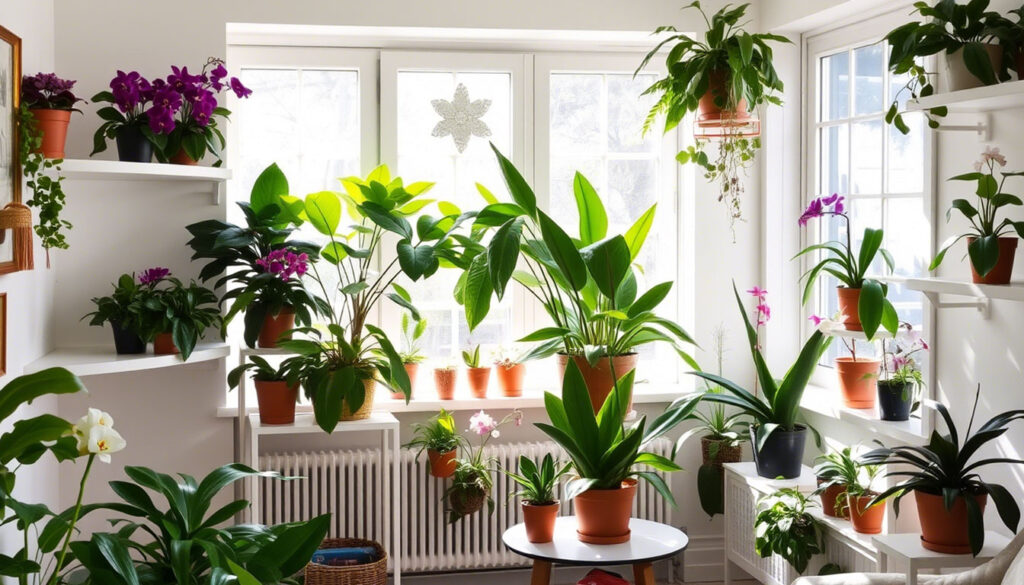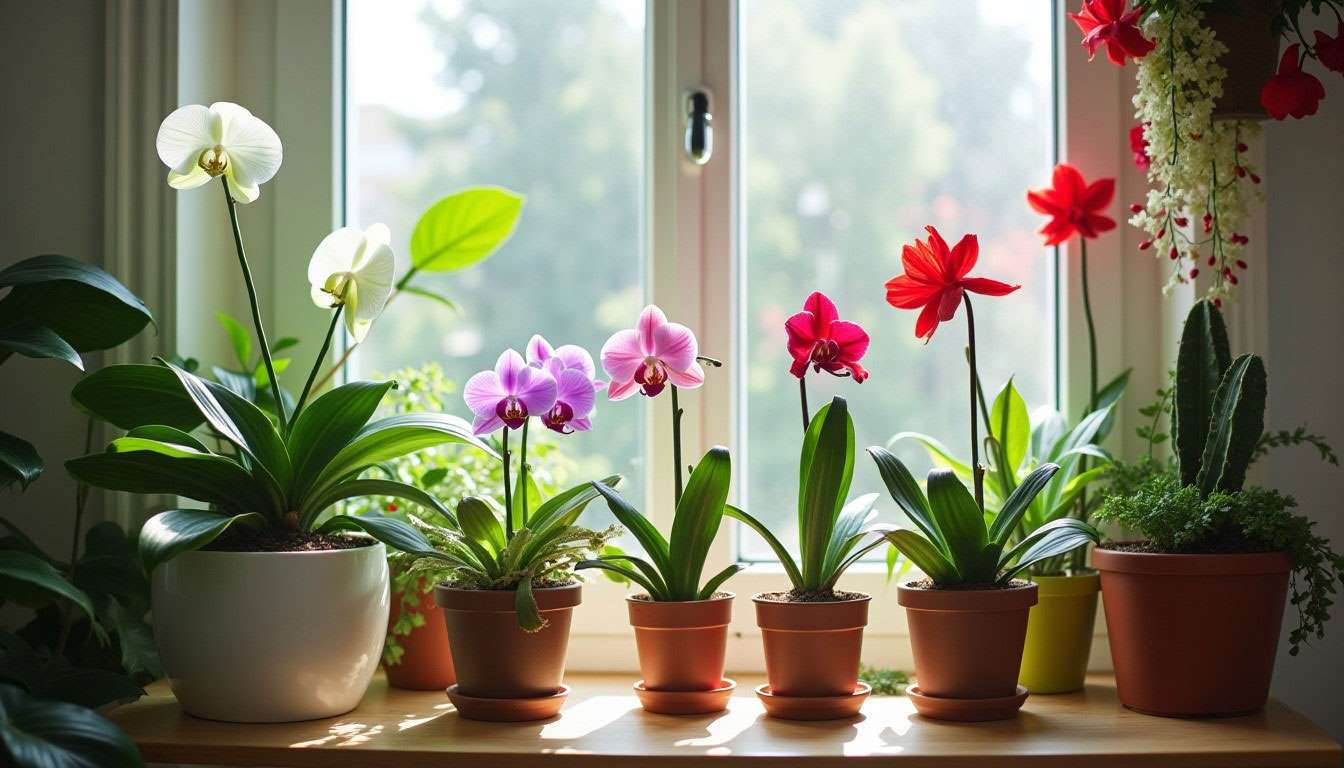Indoor flowers do more than brighten your space—they enhance well-being and improve air quality. These vibrant plants help purify the air, boost humidity, and reduce stress. Indoor gardening is the best hobby. Whether you work from home, enjoy gardening, or want to add a splash of color to your living space, indoor flowers make a great choice. Plants like African Violets, Peace Lilies, and Orchids thrive indoors, offering beauty and a connection to nature year-round.
Studies show that indoor plants contribute to mental clarity, improve mood, and accelerate illness recovery. By introducing flowering plants into your home, you create a relaxing environment while enjoying the satisfaction of nurturing living things.
What are Indoor Flowers?
Indoor flowers are plants that grow inside homes, bringing beauty, color, and fresh air to living spaces. They range from low-light Peace Lilies to sun-loving Orchids. They boost mood, improve air quality, and create a calming atmosphere, making them perfect for home or office environments.

Indoor Flower Care Basics
Indoor flowers require attention to light, watering, soil, temperature, and humidity. By following these fundamental care tips, you can ensure healthy and long-lasting blooms.
Light Requirements
Most indoor flowering plants need bright, indirect sunlight to flourish. Place them near a south or east-facing window for optimal growth. However, some plants, like the Peace Lily, can tolerate low-light conditions.
If your home has limited natural light, consider using LED grow lights to supplement the lighting needs of your flowers. Rotate plants periodically to ensure even light exposure and prevent leaning.
Watering Tips
Overwatering is one of the biggest mistakes when caring for indoor flowers. To prevent root rot, allow the top inch of soil to dry before watering. Always use pots with drainage holes to ensure excess water escapes.
Some plants, like African Violets, prefer bottom watering to keep their leaves dry and free from water spots. Understanding the specific needs of your plant helps maintain optimal moisture levels.
Soil & Fertilizer
Indoor flowering plants need well-draining soil. Choose a high-quality potting mix that suits the plant type. Orchids, for example, thrive in a special orchid mix, while succulents like Crown of Thorns require sandy, fast-draining soil.
Feed your plants with a balanced liquid fertilizer during the growing season (spring and summer). Reduce feeding during fall and winter when plant growth slows.
Temperature & Humidity
Most indoor flowers prefer temperatures between 60–75°F (15–24°C). Avoid placing plants near drafts, heating vents, or air conditioners, as sudden temperature changes can stress them.
Humidity plays a crucial role in flower health. Increase humidity levels by grouping plants using pebble trays or running a humidifier. Tropical plants like Orchids and Jasmine thrive in higher humidity.
Comparison
| Plant | Light Needs | Watering Needs | Special Care |
|---|---|---|---|
| Peace Lily | Low to Medium | Moist | Avoid overwatering |
| African Violet | Bright, Indirect | Water from bottom | Avoid getting water on leaves |
| Phalaenopsis Orchid | Bright, Indirect | Dry to the touch | Well-draining potting mix |
| Amaryllis | Bright | Sparingly until growth | Save bulb and rebloom annually |
| Anthurium | Bright, Indirect | Moist | Consistent moisture |
| Kalanchoe | Bright | Sparingly | Allow soil to dry out between waterings |
| Christmas Cactus | Bright, Indirect | Slightly Moist | Cooler temps in fall to encourage blooming |
| Bromeliad | Bright, Indirect | Central cup and soil | Keep a central cup filled with water |
| Streptocarpus | Bright, Indirect | Consistently Moist | Avoid getting water on leaves |
| Crown of Thorns | Bright, Direct | Sparingly | Allow soil to dry out between waterings |
| Lipstick Plant | Bright, Indirect | Top inch dry | Allow the top inch of soil to dry out between waterings |
| Jasmine | Bright, Direct | Consistently Moist | Provide a trellis for climbing |
| Gloxinia | Bright, Indirect | Water from bottom | High humidity |
| Hydrangea | Bright, Indirect | Moist | Can be challenging indoors |
 Top Indoor Flowers for Every Home
Top Indoor Flowers for Every Home
Different indoor flowers suit different environments. Whether you have a bright, sunlit home or a cozy, shaded corner, there is a perfect plant for your space.
Low-Light Indoor Flowers
Peace Lily
- Light Needs: Low to medium.
- Watering: Keep soil moist but not soggy.
- Special Care: Avoid overwatering.
- Blooms: Spring and summer.
Peace Lilies are low-maintenance plants that also help cleanse the air. They produce elegant white blooms and grow in lower light conditions, making them ideal for offices or dim rooms.
African Violet
- Light Needs: Bright, indirect.
- Watering: Water from the bottom.
- Special Care: Protect velvety leaves from water.
- Blooms: Year-round.
African Violets are compact and vibrant, producing stunning purple, pink, or white flowers. To prevent leaf damage, water from below by placing the pot in a shallow dish of water.
Bright Light Indoor Flowers
Phalaenopsis Orchid
- Light Needs: Bright, indirect.
- Watering: When soil is dry.
- Special Care: Use an orchid mix for proper aeration.
- Blooms: Last for months.
Orchids bring an exotic touch to any room. They require good airflow and careful watering to prevent root rot but reward you with breathtaking, long-lasting blooms.
Crown of Thorns
- Light Needs: Full sun.
- Watering: Drought-tolerant, occasional watering.
- Special Care: Thrives in dry conditions.
- Blooms: Year-round.
Crown of Thorns is a resilient succulent with bright red flowers. It flourishes in sunny spots and needs minimal watering, making it an excellent choice for busy plant lovers.
Seasonal Flowers
Christmas Cactus
- Light Needs: Bright, indirect.
- Watering: Keep soil slightly moist.
- Special Care: Cooler temperatures in the fall encourage blooming.
- Blooms: Winter.
Christmas Cactus is a festive favorite, producing stunning pink or red flowers during the holiday season. To trigger blooming, reduce watering and lower temperatures in the fall.
Amaryllis
- Light Needs: Bright, indirect.
- Watering: Moderate.
- Special Care: Store bulbs for reblooming.
- Blooms: Winter.
Amaryllis boasts dramatic, large flowers in red, white, and pink. After blooming, save the bulbs for future flowering seasons.
Fragrant Flowers
Jasmine
- Light Needs: Bright light.
- Watering: Moderate.
- Special Care: Provide a trellis or support for climbing.
- Blooms: Year-round.
Jasmine fills a room with its sweet fragrance. It requires support to climb and grows best in bright, indirect light.
Lipstick Plant
- Light Needs: Bright, indirect.
- Watering: Let the upper inch of soil become dry to the touch.
- Special Care: Ideal for hanging baskets.
- Blooms: Year-round.
Lipstick Plants feature unique red buds that resemble lipstick tubes. They thrive in warm, humid conditions and look stunning in hanging baskets.
Troubleshooting Common Issues
Even with proper care, indoor flowers can experience problems. As a guide, some common issues and defects are listed with solutions:
Yellow Leaves?
Overwatering or poor drainage can cause yellow leaves. Adjust your watering schedule and ensure your pot has drainage holes.
No Blooms?
If your plant isn’t blooming, it may not be receiving enough light. Try relocating it to a more luminous spot, or consider supplementing natural light with grow lights.
Pest Problems?
Aphids and spider mites can damage indoor plants. Tackle infestations using neem oil or insecticidal soap for effective treatment. Regularly inspect leaves to catch infestations early.
Root Rot?
If your plant has mushy, black roots, it’s likely suffering from root rot. Trim the damaged roots and repot them in fresh, well-draining soil.
Why Indoor Flowers Matter
Indoor flowers do more than decorate your home—they improve air quality, boost mood, and create a peaceful environment. Scientific studies suggest that caring for plants reduces stress and enhances focus. Whether you prefer a low-maintenance Kalanchoe or a fragrant Jasmine, growing flowers indoors is a rewarding hobby.
Conclusion
Bringing indoor flowers into your home is a simple yet impactful way to enhance your living space and well-being. With the right care, these beautiful plants offer year-round joy, cleaner air, and a touch of nature’s serenity. Whether you choose a resilient Peace Lily or an elegant Orchid, nurturing indoor blooms fosters relaxation and a deeper connection with nature.


 Top Indoor Flowers for Every Home
Top Indoor Flowers for Every Home
